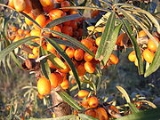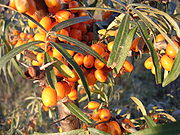
Sea buckthorn oil
Encyclopedia

Sea-buckthorn
The sea-buckthorns are deciduous shrubs in the genus Hippophae, family Elaeagnaceae. The name sea-buckthorn is hyphenated here to avoid confusion with the buckthorns...
identifies a group of species
Species
In biology, a species is one of the basic units of biological classification and a taxonomic rank. A species is often defined as a group of organisms capable of interbreeding and producing fertile offspring. While in many cases this definition is adequate, more precise or differing measures are...
in the genus
Genus
In biology, a genus is a low-level taxonomic rank used in the biological classification of living and fossil organisms, which is an example of definition by genus and differentia...
Hippophae, the most commonly used of which is Hippophae rhamnoides
Hippophae rhamnoides
Hippophae rhamnoides, the common sea-buckthorn, is a deciduous shrub species in the genus Hippophae.Common Sea-buckthorn branches are dense, stiff, and very thorny. The leaves are a distinct pale silvery-green, lanceolate, 3-8 cm long and less than 7 mm broad. It is dioecious, with male and female...
. Oil can be extracted from either the seeds or the pulp of the fruit.
Chemical constituents
Oils from sea-buckthorn seeds and pulp differ considerably in fatty acidFatty acid
In chemistry, especially biochemistry, a fatty acid is a carboxylic acid with a long unbranched aliphatic tail , which is either saturated or unsaturated. Most naturally occurring fatty acids have a chain of an even number of carbon atoms, from 4 to 28. Fatty acids are usually derived from...
composition. While linoleic acid
Linoleic acid
Linoleic acid is an unsaturated n-6 fatty acid. It is a colorless liquid at room temperature. In physiological literature, it has a lipid number of 18:2...
and α-linolenic acid are the major fatty acids in seed oil, sea buckthorn pulp oil contains approximately 65% combined of the monounsaturated fatty acid
Fatty acid
In chemistry, especially biochemistry, a fatty acid is a carboxylic acid with a long unbranched aliphatic tail , which is either saturated or unsaturated. Most naturally occurring fatty acids have a chain of an even number of carbon atoms, from 4 to 28. Fatty acids are usually derived from...
, palmitoleic acid
Palmitoleic acid
Palmitoleic acid, or -9-hexadecenoic acid, is an omega-7 monounsaturated fatty acid with the formula CH35CH=CH7COOH that is a common constituent of the glycerides of human adipose tissue. It is present in all tissues, but generally found in higher concentrations in the liver...
, and the saturated fatty acid, palmitic acid
Palmitic acid
Palmitic acid, or hexadecanoic acid in IUPAC nomenclature, is one of the most common saturated fatty acids found in animals and plants. Its molecular formula is CH314CO2H. As its name indicates, it is a major component of the oil from palm trees . Palmitate is a term for the salts and esters of...
. Few other vegetable oils contain a similar quantity of these fatty acids. Both the seed and pulp oils are rich in tocopherol
Tocopherol
Tocopherols are a class of chemical compounds of which many have vitamin E activity. It is a series of organic compounds consisting of various methylated phenols...
s, tocotrienol
Tocotrienol
Tocotrienols are members of the vitamin E family. An essential nutrient for the body, vitamin E is made up of four tocopherols and four tocotrienols . The slight difference between tocotrienols and tocopherols lie in the unsaturated side chain having three double bonds in its farnesyl isoprenoid...
s and plant sterol
Sterol
Sterols, also known as steroid alcohols, are a subgroup of the steroids and an important class of organic molecules. They occur naturally in plants, animals, and fungi, with the most familiar type of animal sterol being cholesterol...
s. In addition, the pulp oil
contains especially high levels of carotenoid
Carotenoid
Carotenoids are tetraterpenoid organic pigments that are naturally occurring in the chloroplasts and chromoplasts of plants and some other photosynthetic organisms like algae, some bacteria, and some types of fungus. Carotenoids can be synthesized fats and other basic organic metabolic building...
s.
Characteristics
Due to its unique botanical and nutritional properties, and there being no reported evidence of sea-buckthorn oil causing adverse reactions or negative side effects, the oil is also used as a natural agent that may benefit diseases of mucous membraneMucous membrane
The mucous membranes are linings of mostly endodermal origin, covered in epithelium, which are involved in absorption and secretion. They line cavities that are exposed to the external environment and internal organs...
s, including Aphthous ulcer
Aphthous ulcer
An aphthous ulcer , also known as a canker sore, is a type of mouth ulcer which presents as a painful open sore inside the mouth or upper throat characterized by a break in the mucous membrane. Its cause is unknown, but they are not contagious...
s, esophagitis
Esophagitis
Esophagitis is inflammation of the esophagus. It may be acute or chronic. The acute esophagitis can be catarrhal or phlegmonous, whereas the chronic esophagitis may be hypertrophic or atrophic.-Infectious:...
, acid reflux, and peptic ulcers, as well as dermatological diseases and skin conditions.
Uses
In Russia and China, pulp oil may also be used topically to treat skin burns from radiation. Due to its ability to absorb ultravioletUltraviolet
Ultraviolet light is electromagnetic radiation with a wavelength shorter than that of visible light, but longer than X-rays, in the range 10 nm to 400 nm, and energies from 3 eV to 124 eV...
rays, pulp oil is purported to reduce risk of radiation burns for Russian astronauts working in space.
Currently, cosmetic companies are adding sea-buckthorn
Sea-buckthorn
The sea-buckthorns are deciduous shrubs in the genus Hippophae, family Elaeagnaceae. The name sea-buckthorn is hyphenated here to avoid confusion with the buckthorns...
oil to anti-aging preparations for skin rejuvenation and accelerated healing properties. It is also being used topically as a natural treatment for eczema
Eczema
Eczema is a form of dermatitis, or inflammation of the epidermis . In England, an estimated 5.7 million or about one in every nine people have been diagnosed with the disease by a clinician at some point in their lives.The term eczema is broadly applied to a range of persistent skin conditions...
, acne rosacea, acne
Acne
Acne is a general term used for acneiform eruptions. It is usually used as a synonym for acne vulgaris, but may also refer to:*Acne aestivalis*Acne conglobata*Acne cosmetica*Acne fulminans*Acne keloidalis nuchae*Acne mechanica...
and acne scars, and as a lotion for minimizing stretch marks
Stretch marks
Stretch marks or striae , as they are called in dermatology, are a form of scarring on the skin with an off-color hue. They are caused by tearing of the dermis, and over time can diminish but not disappear completely....
.

